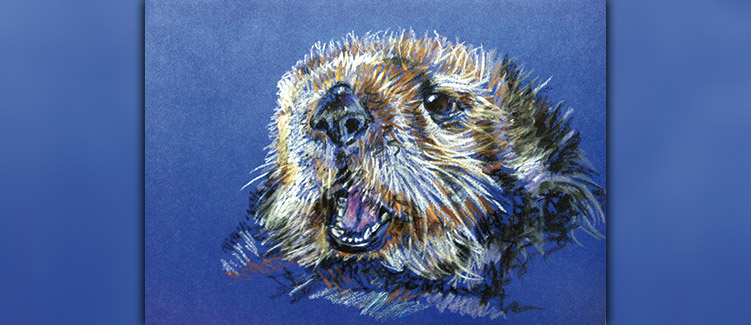Publisher's note: "Endangered Art" is a new column that will feature the dramatic wildlife paintings of noted local artist Anke Fachmann, along with a description of the endangered creatures she has captured with her work.

By Anke Fachmann
Published: January, 2017
Publisher’s note: “Endangered Art” is a new column that will feature the dramatic wildlife paintings of noted local artist Anke Fachmann, along with a description of the endangered creatures she has captured with her work.
When we hear the term “endangered species,” we often think of animals who live far away and dwell in exotic habitats—but unfortunately many animals that live nearer to us are listed on the IUCN Red List. The International Union for Conservation of Nature (IUCN) determines the level of extinction risk, which varies from lower risk, threatened to extinct.
One regional endangered species is the southern sea otter, which can be found along the central California coast from San Mateo to Santa Barbara Counties. In the past, southern sea otters were extensively hunted for their beautiful fur; they were listed as a threatened species in 1977 under the Endangered Species Act and are protected under the Marine Mammal Protection Act. They still face threats such as oil pollution, poachers, infectious diseases, parasites, boat strikes, entanglements and toxins.
The sea otter is considered a keystone species, meaning one that has a disproportionately large effect on its environment relative to its abundance. Sea otters feed on sea urchins, playing a critical role in maintaining the health of kelp forest ecosystems. They also consume filter-feeding benthic invertebrates, resulting in the removal of contaminants and disease-causing pathogens from near-shore waters.
Sea otters are highly effective sentinels of the health of our oceans, making their recovery an important goal of the Marine Mammal Center in Sausalito. You can take action by volunteering, becoming a member or adopting a marine mammal.
For more information, go to www.marinemammalcenter.org.
Anke Fachmann is a graphic designer and artist who currently focuses on portraying endangered species. Transforming animals into artistic, colorful paintings and illustrations gives them a platform to be seen. Treehoppers, tarsiers, maleos and many more come to life on canvas and paper with the use of oil pastels, ink and acrylic paint, which the artist applies with her fingers. Follow her on www.instagram.com/daily_plover or go to www.thoughtsbecomeimages.com.

